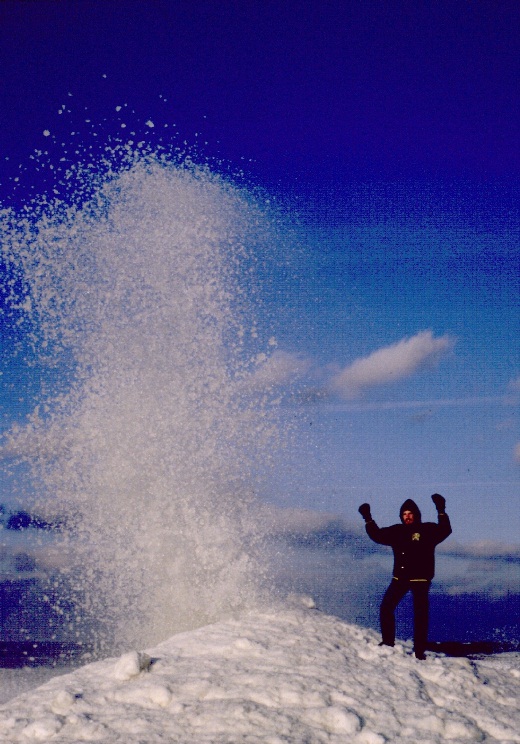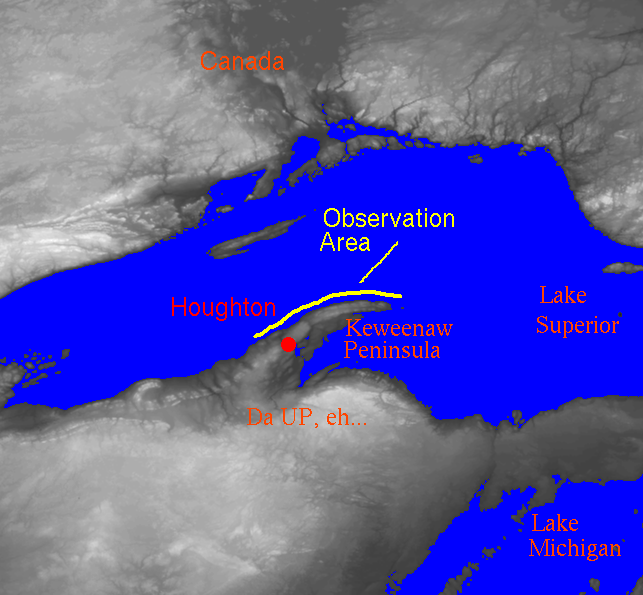
|
|
Ice Volcanoes of Lake Superior's South Shore
Photos and Website Originally Created by Michael Dolan and Paul KimberlyDisclaimer: Our comments about the research.
- What are ice volcanoes and how do they form? See "Ice Volcanoes..." below.
- Will the weather be conducive for some action? Here is the local weather forecast and current conditions for our area.
- Where exactly are we viewing the activity?
- Check out the image collection of ice volcano phenomena on Lake Superior! Clickable mini-pic index (27 small inlined images) . Photos by Mike Dolan and Paul Kimberly 1995.
Material found within this document...
Ice Volcanoes of Lake Superior's South Shore: Preliminary Observations and Hypotheses
Ice volcanoes commonly occur during the winter months along the north shore of Lake Superior. Cones begin to form at the leading edge of the ice shelf as it builds out into the lake. When the waves, driven by strong onshore winds, feel bottom they build and break onto the ice shelf. After the ice shelf has built out, waves continue to travel underneath the ice and are forced up through cracks and previously formed cones.
In this page, we will present the conditions (1-3) neccessary for the phenomenon to occur. We will also discuss the formation (4-5) and resulting physical characteristics (6-8) of the ice volcanoes
1. High Surf
- The intensity and location of "eruptive" activity is primarily controlled
by wave height and direction. In our estimate, waves with amplitudes less than
one meter are too small for cone generation. Activity is best when high
onshore winds are present, typically originating from snow squalls and regional
storms. However, not all onshore winds create proper wave conditions.
2. Formation of Ice on the Lake
 8-bit JPG 24-bit JPG Ice forms on the lake.
8-bit JPG 24-bit JPG Ice forms on the lake.
- The temperature and conditions of the lake surface must be conducive to the formation of ice.
3. Ambient Air Temperature
- For cones to build, ambient air temperatures must be several degrees
(unmeasured) below freezing. "Eruptions" occuring at temperatures at or above
freezing will cause degredation of the cone.
4. Waves Hitting the Leading Edge of Ice Shelf
 8-bit JPG 24-bit JPG Leading edge of thick ice shelf.
8-bit JPG 24-bit JPG Leading edge of thick ice shelf.
- High surf slamming against the face of the ice shelf may result in cone formation. Waves energy can concentrate in small valleys, splashing onto the shelf.
5. Geomorphologic Features Causing Waves to Swell
 8-bit JPG 24-bit JPG Ice built up along a rock reef.
8-bit JPG 24-bit JPG Ice built up along a rock reef.
- Three geomorphologic features of the lake floor have been recognized in
conjuction with cone formation; 1. shoreline 2. sand bar 3. rock reef.
- shoreline
- Activity at the shoreline occurs when the ice shelf first forms. Waves
approaching the shoreline feel bottom, swell and crash onto the shore. Chunks
of ice and lake-spray (spatter) help create a raised ice shelf along the
shoreline. Irregularities along the leading edge of the shelf help concentrate
wave energy into larger waves, thus creating taller ejections of spatter. It
is at the irregularities that ice volcanoes typically form.
- Cones at the leading edge are normally open to the water, however after the
ice shelf has built away from the volcanoes the cones may remain active and
become completely enclosed. Wave energy beneath the ice forces water up through
cracks, openings and previously formed cones as the wave feels bottom.
- Occurance of cones along any particular shoreline is dependant upon
offshore bathymetry. Bays or shorelines protected by offshore rock reefs
and/or sand bars rarely receive enough wave energy to create ice volcanoes.
- sand bars
- The same phenomenon described for shorelines generally occurs as the
prograding ice shelf reaches a sand bar. At this point the progradation of the
ice shelf is retarded due to the increased energy of the breaking waves. The
ice sheet provides a surface for spatter to collect and coalesce. Sand bars
are generally surrounded by slightly deeper water than shorelines, creating
conditions for larger cones (discussed below).
- rock reef
- Two types of rock reefs are observed: 1. subaqueous 2. subaerial
- Subaqueous
- Cones forming at subaqueous reefs exhibit the same behavior as those at sand bars.
- Subaerial
- The subaerial reefs acts similar to the leading edge of
the ice shelf. Spatter from the breaking waves coalesce, extending the height
of the reef. Irregularities in the reef concentrate wave energy accentuating
the process. It is not necessary for the backwaters to be frozen prior to cone
formation.
6. Morphology
-
 8-bit JPG 24-bit JPG 10 meter high ice volcano.
8-bit JPG 24-bit JPG 10 meter high ice volcano.
- Ice volcanic cones range in size from less than one meter to greater than 8
meters in height, measured from base to peak. The largest cones typically
occur in areas exposed to high energy waves (offshore sand bars and rock reefs).
 8-bit JPG 24-bit JPG A view from the lake of a breached ice volcano.
8-bit JPG 24-bit JPG A view from the lake of a breached ice volcano.
 8-bit JPG 24-bit JPG Symmetrical unbreached cone.
8-bit JPG 24-bit JPG Symmetrical unbreached cone.
- Only two shapes of cones (shield volcano and stratovolcano) have been
observed to exhibit two forms of symmetry (breached and unbreached).
Observations to date do not reveal relationships between size, shape and
symmetry. However, the formation of cones can be related to symmetry. Cones
forming on the leading edge of the ice shelf are breached in the lakeward
direction. "Eruptions" occuring landward from the shelf's edge form unbreached
cones.
7. Arcs
 8-bit JPG 24-bit JPG Arc of evenly spaced ice volcanoes along a rock reef.
8-bit JPG 24-bit JPG Arc of evenly spaced ice volcanoes along a rock reef.
 8-bit JPG 24-bit JPG Two arc sets composed of shield and stratovolcanoes of ice.
8-bit JPG 24-bit JPG Two arc sets composed of shield and stratovolcanoes of ice.
- Ice volcanoes are prototypically aligned in arcs that follow the strike of
the associated geomorphologic features (shorelines, sand bars and rock reefs).
Cones contained with in the arcs are usually evenly spaced, however, random
spacing is not uncommon. Successive arcs will form in areas that contain
parallel assemblages of sand bars. Cones comprising the arcs display a
lakeward increase in size.
8. "Cold Spot" Ice Volcanoes
- "Cold spot" ice volcanoes are nearly symmetrical single cones that
apparently are not related to shoreline, sand bar or rock reef arcs. We have
designated them "cold spot" volcanoes due to their solitary existance. They
occur near shore and are apparently associated with zones of weakness in the
ice. "Cold spot" ice volcanoes have yet to be observed in their active state.
1. High Surf
2. Formation of Ice on the Lake
 8-bit JPG 24-bit JPG Ice forms on the lake.
8-bit JPG 24-bit JPG Ice forms on the lake.
3. Ambient Air Temperature
4. Waves Hitting the Leading Edge of Ice Shelf
 8-bit JPG 24-bit JPG Leading edge of thick ice shelf.
8-bit JPG 24-bit JPG Leading edge of thick ice shelf.
5. Geomorphologic Features Causing Waves to Swell
 8-bit JPG 24-bit JPG Ice built up along a rock reef.
8-bit JPG 24-bit JPG Ice built up along a rock reef.
- shoreline
- Activity at the shoreline occurs when the ice shelf first forms. Waves approaching the shoreline feel bottom, swell and crash onto the shore. Chunks of ice and lake-spray (spatter) help create a raised ice shelf along the shoreline. Irregularities along the leading edge of the shelf help concentrate wave energy into larger waves, thus creating taller ejections of spatter. It is at the irregularities that ice volcanoes typically form.
- Cones at the leading edge are normally open to the water, however after the ice shelf has built away from the volcanoes the cones may remain active and become completely enclosed. Wave energy beneath the ice forces water up through cracks, openings and previously formed cones as the wave feels bottom.
- Occurance of cones along any particular shoreline is dependant upon offshore bathymetry. Bays or shorelines protected by offshore rock reefs and/or sand bars rarely receive enough wave energy to create ice volcanoes.
- sand bars
- The same phenomenon described for shorelines generally occurs as the prograding ice shelf reaches a sand bar. At this point the progradation of the ice shelf is retarded due to the increased energy of the breaking waves. The ice sheet provides a surface for spatter to collect and coalesce. Sand bars are generally surrounded by slightly deeper water than shorelines, creating conditions for larger cones (discussed below).
- rock reef
- Two types of rock reefs are observed: 1. subaqueous 2. subaerial
- Subaqueous
- Cones forming at subaqueous reefs exhibit the same behavior as those at sand bars.
- Subaerial
- The subaerial reefs acts similar to the leading edge of the ice shelf. Spatter from the breaking waves coalesce, extending the height of the reef. Irregularities in the reef concentrate wave energy accentuating the process. It is not necessary for the backwaters to be frozen prior to cone formation.
- Cones forming at subaqueous reefs exhibit the same behavior as those at sand bars.
- Activity at the shoreline occurs when the ice shelf first forms. Waves approaching the shoreline feel bottom, swell and crash onto the shore. Chunks of ice and lake-spray (spatter) help create a raised ice shelf along the shoreline. Irregularities along the leading edge of the shelf help concentrate wave energy into larger waves, thus creating taller ejections of spatter. It is at the irregularities that ice volcanoes typically form.
6. Morphology
 8-bit JPG 24-bit JPG 10 meter high ice volcano.
8-bit JPG 24-bit JPG 10 meter high ice volcano.
 8-bit JPG 24-bit JPG A view from the lake of a breached ice volcano.
8-bit JPG 24-bit JPG A view from the lake of a breached ice volcano.
 8-bit JPG 24-bit JPG Symmetrical unbreached cone.
8-bit JPG 24-bit JPG Symmetrical unbreached cone.
7. Arcs
 8-bit JPG 24-bit JPG Arc of evenly spaced ice volcanoes along a rock reef.
8-bit JPG 24-bit JPG Arc of evenly spaced ice volcanoes along a rock reef.
 8-bit JPG 24-bit JPG Two arc sets composed of shield and stratovolcanoes of ice.
8-bit JPG 24-bit JPG Two arc sets composed of shield and stratovolcanoes of ice.
8. "Cold Spot" Ice Volcanoes
More Pictures of Ice Volcanoes
Questions? or Comments! geo@mtu.edu
From
the Geological & Mining Engineering & Sciences Dept.
Visit
these web sites:
Aurora
Page: A collection of the best links and a great
image archive of the Aurora Borealis:
Volcanoes Page:One of
the top sites for volcano information
Interested in Mining History? Take a look at the Michigan Mining School History pages,
or the Michigan
Mining History links. Visit the archival photos of historic mines
in Michigan where many of the gems and minerals came from: Mine
Shafts of Michigan
|
|||

